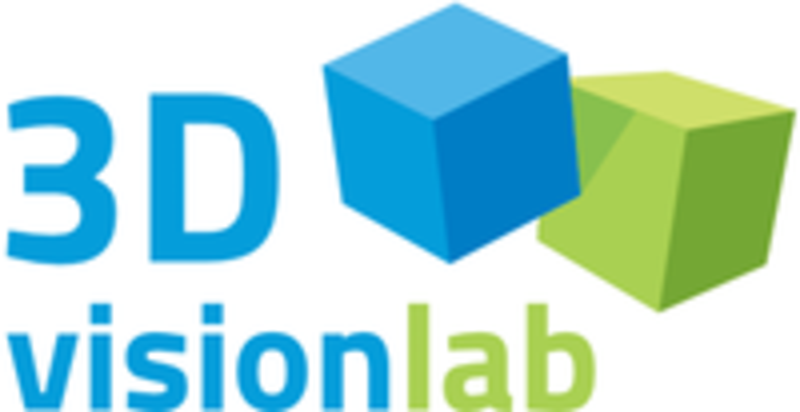The equipment of the laboratory includes a selection of metrology techniques which are widely used in the industrial environment: from the recording and evaluation of two-dimensional projections for automatic visual inspection to the fully automated three-dimensional digitization of components using a strip light projector.
We also develop and test prototypes and experimental sensors ourselves. Within the scope of research projects, we develop the optimal strategy to be able to record the right data at the right time.
Structered light projection (Fringe Projection)
3D Object detection with Structered light projection
by observing a given scene from two distinct perpectives, one can extract depth information from the shift of certain image points. The human eye uses the same principle.
In order to cleary identify a point in two images (s.c. correspondence problem), the surface of an object will be encoded with a series of fringe patterns. Capturing this sequence with two cameras enables this technique to uniquely identify the pixel coordinates of one point in both images and therefore calculate the point coordinates in three dimensional space through triangulation. This enables a high resolution measurement of object surfaces, which can be used for nominal/actual dimensions comparsion, or in order to digitize machined parts without the need of a technical drawing.
Light Cut Method
Light cut is a 3D metrology technique. The technique is based on triangulation which can be used to calculate three dimensional surface information. Typically a light cut system is composited of a laser, which projects a line on a test object and a camera at a certain angle relativ to the LASER, which captures an image of the LASER line.
Modular system with camera and LASER
This modular system consists of a C2 camera from Automation Technologies and a line LASER from Z-Laser. The camera processes the acquired image on-board and outputs the calculated depth profile. The modular nature of this system enables fully felxible setups in regards to working distance and surface topology.
Specifications:
- Data points: 2048 x 1088 Pixel
- Pixel size: 5,5 µm x 5,5 µm
- Frame rate: 340 - 1400 profiles per second
- Wavelength: 660nm (red)
Time of Flight
Time of flight is a term for a measuring distances by determining the travel time of light pulses. By sending out light pulses and measuring the time between emission and detection of the reflected light pulses, the distance between the object and the sensor can be calculated due to the fixed speed of light.
A time of flight camera will acquire a two dimensional projection of a given scene. With the calculated height information a three dimensional point cloud is generated. Due to the relative high frame rates of such cameras, they can be used for object detection and collision prevention for driverless car operation.
Laser scanning is a secondary application of the time of flight method, where big objects such as geographic features or big buildings are scanned point by point.
Lab equipment
O3D302 by the company ifm electronic gmbh
Specifications:
- Resolution: 176 x 132 Pixel
- Frequency: 25 fps
Sensorprograms:
- Objectmeasurement
- Completeness control
- Fill level control
- Distance control
- Volumne control
SR 4000 Heptagon/Mesal Imaging
Specifications:
- Resolution: 177 x 144 pixel
- Frame rate: 50
- Pixel size: 40 x 40 um
- Working distance: 0 - 10 m
Light field
Light field technology is an image acquisition technique, where additionally to the intensity distribution the angle of incidence of light is recorded. This additional information can be used to reconstruct three dimensional surface information or to change the focus position and depth of field of a image. Apart from camera arrays and various specialized acquisition techniques the light field camera offers a compact solution for light field image acquisiton in industrial environments.
Lab equipment
Light field camera R8 - Raytrix GmbH
Specifications:
- Resolution: 8 megapixeles (2 megapixels effective spatial resolution)
- Optic: microlensarray with 3 different focal lengths, main objective: f = 50mm, F/2.8
- Field of view: e.g. 40 x 30 x 20 mm (x/y/z) with a working distance of 300 mm
- Resolution: 25 x 25 x 150 um (dx/dy/dz) with a working distance of 300 mm
- Acquistion rate: 30 frames per second
2D visual inspection
2D visual inspection is the most basic method for optical metrology in industrial environments. Visual inspection means, that a conventional two dimensional image will be acquired from a work piece and analysed in order to trigger an action from a machine. Therefore all components (camera, objetive, illumination, acquisition hardware) have to be perfectly matched in order to reliably solve the metrology problem, (e.g. dimensional metrology, thread inspection, ...)
Our lab has the equipment to implement and test even complex 2D visual inspection methods. From image to decision!
Lab equipment
- Optical table, rail and tripods
- Motorized rotation and translation stages
- Lens and mirror kits
- Various objectives (entozentrisch/telecentric)
- Various cameras and sensors
- Various illumination systems (spot, toplight, through light, dome, tlecentric illumination)
- LASER spot and line
- Software and hardware for image processing






